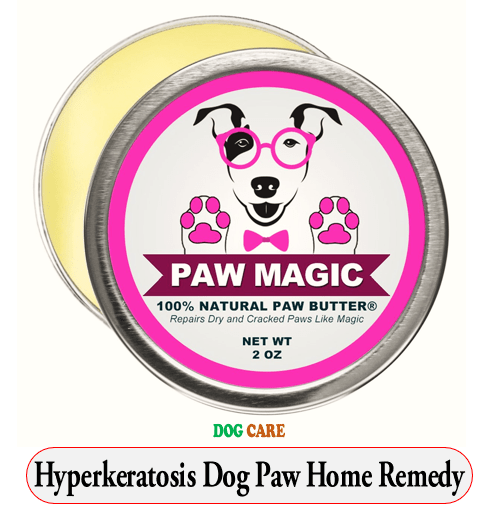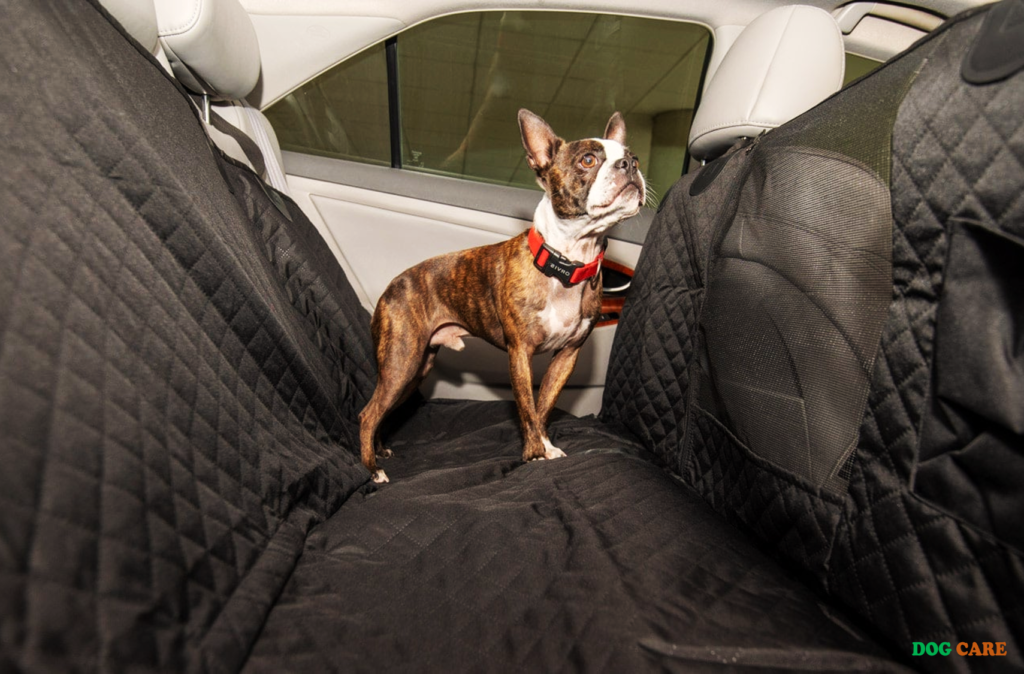Hyperkeratosis Dog Paw Home Remedy – Hyperkeratosis dog paw can be treated at home using remedies such as moisturizing the paws and applying a balm or ointment specifically designed for dogs. Dry, cracked, and rough paw pads in dogs can be a result of a condition called hyperkeratosis.
This condition causes an abnormal growth of keratin, leading to thickened and hardened paw pads. While it can be uncomfortable for our furry friends, there are home remedies that can provide relief. By following simple steps, such as moisturizing the paws and using specialized balms or ointments, you can help improve your dog’s paw condition.
Implementing these remedies can bring back the comfort and joy for your four-legged companion in no time. Read on to discover effective ways to address hyperkeratosis in your dog’s paws and restore their paw pads to optimal health.

Understanding Hyperkeratosis Dog Paw Home Remedy
Hyperkeratosis in dogs can cause thickening and hardening of the paw pads. If you’re looking for a home remedy, try applying moisturizing balms or using natural oils to soften and nourish the affected areas.
What Is Hyperkeratosis?
Hyperkeratosis is a common condition that affects the paws of dogs. It causes the skin on their paw pads to become thick, dry, and cracked. This condition can be uncomfortable and painful for your furry companion. Understanding hyperkeratosis is crucial for early detection and effective treatment. Let’s explore what hyperkeratosis is, its causes, and the signs and symptoms to watch out for.
Causes Of Hyperkeratosis In Dogs
Hyperkeratosis in dogs can be caused by various factors, including:
- Genetic predisposition: Certain breeds, such as Labradors, Golden Retrievers, and Irish Setters, are more prone to developing hyperkeratosis.
- Age: This condition is more commonly seen in older dogs, as their paw pads naturally become less elastic over time.
- Autoimmune disorders: In some cases, hyperkeratosis may be a result of an underlying autoimmune condition that affects the dog’s immune system.
- Infections: Bacterial or fungal infections can contribute to the development of hyperkeratosis in dogs.
Signs And Symptoms Of Hyperkeratosis In Dogs
Recognizing the signs and symptoms of hyperkeratosis in dogs is essential in order to seek appropriate treatment. Look out for the following indications:
- Thickened paw pads: The skin on the paw pads becomes excessively thick and rough.
- Cracked and dry skin: The paw pads may appear cracked and have a dry, flaky texture.
- Pain and discomfort: Dogs with hyperkeratosis may experience pain, limping, and discomfort while walking or running.
- Difficulty walking: The thickened skin can impair your dog’s mobility, making it challenging for them to walk or maintain their balance.
- Lesions and sores: In severe cases, the cracked skin may lead to the formation of lesions and sores.
- Inflammation and redness: The affected areas may become inflamed, causing redness and irritation.
Understanding hyperkeratosis and its associated signs and symptoms empowers you to take early action in providing relief for your dog. By recognizing the causes and manifestations of this condition, you can seek appropriate treatment and provide your furry friend with the care they need to live comfortably.
Importance Of Paw Care For Dogs With Hyperkeratosis
Proper paw care is crucial for dogs with hyperkeratosis, a condition characterized by excessive skin growth on their paws. To provide relief, a home remedy can be used to soften and nourish the paw pads, improving your dog’s comfort and overall well-being.
Why Is Paw Care Essential For Dogs With Hyperkeratosis?
Proper paw care is crucial for dogs with hyperkeratosis due to the unique challenges they face. Hyperkeratosis is a condition that causes a thickening and hardening of the skin on a dog’s paws. While it may seem like a mere cosmetic issue, it can lead to discomfort and potential complications if not addressed promptly.
Consequences Of Neglecting Paw Care In Dogs With Hyperkeratosis
Neglecting paw care in dogs with hyperkeratosis can have significant consequences, including:
- Pain and Discomfort: The thickened and hardened skin can cause pain, discomfort, and even limping. This can affect the dog’s overall quality of life and ability to move comfortably.
- Cracks and Fissures: The hardened skin is more prone to developing cracks and fissures, which can lead to bleeding, infections, and further discomfort for the dog.
- Infections: Open cracks in the paw pads can serve as entry points for bacteria and other pathogens, increasing the risk of infections. These infections can be painful, difficult to treat, and may require veterinary intervention.
- Impaired Mobility: Hyperkeratosis can cause the paw pads to become thick and excessively rough. This can make it difficult for dogs to walk and run normally, affecting their overall mobility and physical activity levels.
Overall, neglecting paw care in dogs with hyperkeratosis can lead to a decrease in their quality of life and potentially worsen their condition. It is essential to prioritize regular paw care to minimize discomfort, prevent complications, and maintain their overall well-being.
Home Remedies For Soothing Your Dog’s Rough Paws
If your furry friend is suffering from hyperkeratosis, you know how uncomfortable and painful it can be for them. Hyperkeratosis is a condition where the skin on your dog’s paws becomes dry, rough, and calloused. While it’s always best to consult your veterinarian for proper diagnosis and treatment, there are some home remedies you can try to help soothe your dog’s rough paws. These remedies focus on moisturizing, exfoliating, and protecting your dog’s paws, providing relief and promoting healthy paw pads.
Moisturizing Remedies For Hyperkeratosis Paws
Moisturizing your dog’s paws is crucial in relieving the discomfort caused by hyperkeratosis. Here are some effective home remedies to keep your dog’s paws moisturized:
- Apply a paw balm or moisturizing cream specifically formulated for dogs. These products contain ingredients like shea butter, coconut oil, and bee wax, which provide deep hydration and nourishment.
- Try using natural remedies like olive oil or coconut oil. These oils have natural moisturizing properties that can help soften and soothe your dog’s rough paws. Apply a small amount to their paws and gently massage it in.
- Consider using vitamin E oil. This powerful antioxidant not only moisturizes the skin but also promotes healing. It can be applied directly to your dog’s paws or added to their regular paw balm for an extra boost of hydration.
Exfoliating Treatments To Reduce Roughness
In addition to moisturizing, exfoliation can help reduce the roughness and thickening of your dog’s paw pads. Here are some exfoliating treatments you can try:
- Gently scrub your dog’s paws with a soft-bristle brush or a pumice stone. This will help remove the dead skin cells and promote the growth of healthier skin.
- Soak your dog’s paws in a mixture of warm water and Epsom salt. The salt acts as a gentle exfoliant, helping to slough off rough patches and soften the skin. Remember to dry their paws thoroughly after soaking.
- Consider using a commercial paw pad exfoliating product. These products are designed specifically for dogs and contain ingredients like papain enzyme or AHA (alpha hydroxy acid) to help remove dead skin cells and promote smoother paw pads.
Protective Measures To Prevent Further Damage
Once you’ve moisturized and exfoliated your dog’s paws, it’s important to take preventative measures to avoid further damage. Here are some protective measures you can implement:
- Keep your dog’s paws clean and dry. Moisture accumulation can worsen hyperkeratosis, so make sure to dry their paws thoroughly after walks or outdoor play.
- Use paw wax or protective balms. These products create a barrier between your dog’s paws and harsh surfaces, preventing excessive dryness and roughness.
- Consider using dog booties or socks. These provide an extra layer of protection and can help prevent your dog’s paws from becoming irritated or injured.
- Regularly trim your dog’s nails and the excess fur around their paw pads. Long nails and excessive fur can contribute to the development of hyperkeratosis and worsen the condition.
Remember, while these home remedies can provide relief for your dog’s rough paws, it’s essential to consult with your veterinarian for a proper diagnosis and treatment plan. Together with proper veterinary care and these home remedies, you can help your furry friend find comfort and promote healthy paw pads.

Natural Ingredients And Products For Paw Care
Discover the best hyperkeratosis dog paw home remedy with natural ingredients and products for paw care. Say goodbye to rough paws and provide soothing relief for your furry friend.
Natural Ingredients and Products for Paw Care Taking care of your furry friend’s paws is essential for their overall well-being. Rough paws, regardless of the cause, can be uncomfortable and even painful for dogs. To provide them with relief, it’s important to explore natural remedies that are both gentle and effective. In this blog post, we will discuss the benefits of natural ingredients for paw care, the top natural ingredients for soothing rough paws, and recommended products specifically designed for hyperkeratosis paw care.
Benefits Of Natural Ingredients For Paw Care
Using natural ingredients for paw care offers various benefits that can greatly contribute to the health and comfort of your dog’s paws. These benefits include:
1. Moisturization: Natural ingredients such as coconut oil, shea butter, and aloe vera possess excellent moisturizing properties. They help to nourish and hydrate the paw pads, keeping them soft and supple.
2. Antibacterial and Antifungal Properties: Some natural ingredients like tea tree oil and lavender oil have antimicrobial properties, which can help prevent infections caused by bacteria or fungi on your dog’s paws.
3. Anti-inflammatory Effects: Certain natural ingredients like chamomile and calendula have anti-inflammatory properties that can help soothe irritated and inflamed skin on the paw pads.
4. Enhanced Healing: Natural ingredients like honey and neem oil possess healing properties that can aid in the regeneration of damaged tissues, promoting quicker healing of cuts or cracks on your dog’s paws.
Top Natural Ingredients For Soothing Rough Paws
When it comes to soothing rough paws, several natural ingredients have proven to be highly effective. These include:
1. Coconut Oil: Loaded with essential fatty acids and antioxidants, coconut oil is a versatile ingredient known for its moisturizing and soothing properties.
2. Shea Butter: With its high concentration of vitamins A and E, shea butter offers deep moisturization and helps protect the paw pads from harsh environmental elements.
3. Aloe Vera: This natural ingredient is renowned for its cooling and healing properties. Aloe vera gel can provide relief to rough and inflamed paw pads.
4. Tea Tree Oil: With powerful antifungal and antibacterial properties, tea tree oil can help combat infections and irritations on your dog’s paws.
5. Chamomile: Chamomile has soothing and anti-inflammatory effects, making it an excellent ingredient for addressing inflamed and irritated paw pads.
Recommended Products For Hyperkeratosis Paw Care
When it comes to treating hyperkeratosis, there are specific products designed to address this condition effectively. Some recommended products for hyperkeratosis paw care include:
1. Paw balms: Choose paw balms that contain a combination of natural ingredients like shea butter, coconut oil, and beeswax. These balms provide deep moisturization and help soften the hardened keratin on the paw pads.
2. Paw creams: Look for paw creams infused with healing ingredients such as neem oil, calendula extract, and vitamin E. These creams can aid in the softening and healing of hyperkeratotic paw pads.
3. Paw soaks: Consider using paw soaks that contain oatmeal, aloe vera, and chamomile extracts. These ingredients help soothe and moisturize rough paw pads, reducing discomfort caused by hyperkeratosis. Incorporating these natural ingredients and products into your dog’s paw care routine can make a significant difference in keeping their paws healthy and comfortable. Remember to consult with your veterinarian before trying any new remedy or product, especially if your dog has any existing medical conditions.
Tips For Incorporating Paw Care Into Your Dog’s Routine
Proper paw care is essential for dogs with hyperkeratosis. Incorporating a home remedy routine can soothe discomfort and prevent further complications.
Dogs rely on their paws for a variety of activities, from running and jumping to digging and exploring. Just like humans, dogs need regular paw care to keep their paws healthy and comfortable. Incorporating paw care into your dog’s routine can help prevent various issues, including hyperkeratosis, a condition where the skin on the paw pads becomes thick and crusty. By following these simple tips, you can ensure that your furry friend’s paws stay in top shape.
Creating A Regular Paw Care Routine
To maintain your dog’s healthy paws, it’s essential to establish a regular paw care routine. This routine should include the following steps:
1. Inspect Regularly: Take a few minutes each day to inspect your dog’s paws. Look for any signs of redness, swelling, or cuts. Catching problems early can prevent them from worsening.
2. Cleanse Gently: Use a mild, dog-friendly cleanser and warm water to gently clean your dog’s paws. This removes dirt, debris, and bacteria that may have accumulated during walks or outdoor play.
3. Moisturize: Apply a dog-safe paw balm or moisturizer to your dog’s pads. This helps keep the skin hydrated and prevents excessive dryness or cracking. Look for products specifically designed for dogs to ensure their safety.
Ensuring Your Dog’s Comfort During Paw Care
While performing paw care, it’s important to prioritize your dog’s comfort. Follow these tips to ensure a stress-free experience:
1. Choose a Calm Environment: Find a quiet and comfortable area where you can clean and examine your dog’s paws. Minimize distractions to help your dog relax.
2. Use Positive Reinforcement: Reward your dog with treats, praise, or play after each successful paw care session. This positive reinforcement helps create a positive association with paw care and encourages cooperation.
3. Be Gentle: Handle your dog’s paws with care, using gentle motions. Avoid causing any discomfort or pain. If your dog shows signs of discomfort, take a break and try again later.
Seeking Professional Help When Necessary
While regular paw care is usually enough to maintain healthy paws, there may be instances where professional help is required. Consider the following scenarios:
1. Persistent Issues: If your dog’s paw problems persist despite regular care, it’s crucial to consult a veterinarian. They can diagnose underlying issues and recommend an appropriate treatment plan.
2. Hyperkeratosis: If your dog is diagnosed with hyperkeratosis, your veterinarian may suggest specific treatments or remedies. Follow their guidance to manage this condition effectively. Remember, your dog’s paws are their foundation. By incorporating paw care into your dog’s routine, you can help prevent discomfort, promote healthy paws, and ensure that your four-legged companion remains happy and active.
Prevention And Management Of Hyperkeratosis In Dogs
Learn effective home remedies for preventing and managing hyperkeratosis in dogs, focusing specifically on treating the condition in their paws. These remedies provide natural and inexpensive solutions to help alleviate symptoms and improve your dog’s overall paw health.
Preventive Measures To Avoid Hyperkeratosis
Dogs are susceptible to various skin conditions, and one such issue is hyperkeratosis, which affects the paw pads. To keep your furry friend’s paws healthy, it’s essential to take preventive measures that help avoid hyperkeratosis from occurring. These simple yet effective methods can help keep your dog’s paw pads in prime condition:
- Regular paw pad inspections to check for any signs of dryness or thickening.
- Frequent moisturization using paw balm or petroleum jelly to keep the paw pads hydrated.
- Trimming excess hair around the paw pads to prevent dirt and debris from collecting and causing irritation.
- Ensuring your dog walks on safe surfaces to minimize the risk of trauma and excessive wear on the paw pads.
- Using protective footwear, such as dog boots, to provide an additional layer of protection against rough surfaces.
Managing Hyperkeratosis Through Diet And Supplements
Diet plays a crucial role in maintaining your dog’s overall health, including the condition of their paw pads. By incorporating certain foods and supplements into your dog’s diet, you can help manage hyperkeratosis and improve the health of their paw pads:
- Provide a balanced diet rich in Omega-3 fatty acids, which can help reduce inflammation and improve the quality of the skin and coat.
- Incorporate supplements like fish oil or flaxseed oil, which are excellent sources of Omega-3 fatty acids.
- Consider adding a dog-specific multivitamin to ensure your furry friend receives all the necessary nutrients for maintaining healthy skin and paw pads.
- Consult with your veterinarian to determine if any specific dietary changes or supplements are recommended for your dog’s individual needs.
When To Consult A Veterinarian
In some cases, managing hyperkeratosis in dogs may require professional veterinary assistance. It is important to consult with your veterinarian if you notice any of the following concerning signs:
- Severe thickening, cracking, or bleeding of the paw pads.
- Significant discomfort or limping.
- Persistent infections or ulcerations.
- Unresponsive to home remedies and preventive measures.
Your veterinarian will be able to provide a proper diagnosis, recommend appropriate treatment options, and offer guidance tailored to your dog’s specific condition.
Conclusion
There are several effective home remedies to help relieve hyperkeratosis in your dog’s paws. From regular moisturizing to using natural balms and ointments, you can improve your furry friend’s paw health. Remember to consult your veterinarian for proper guidance and advice tailored to your dog’s specific needs.
By taking proactive measures, you can provide your pet with the necessary care to alleviate discomfort and promote overall paw health.


